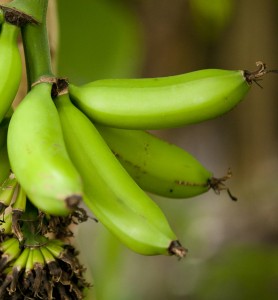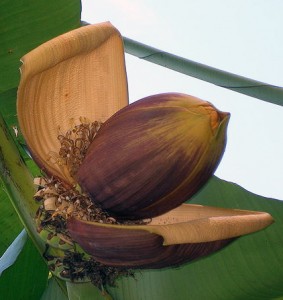Going Bananas
Posted in Gardening Tips on January 14 2014, by Sonia Uyterhoeven
Sonia Uyterhoeven is the NYBG‘s Gardener for Public Education.
 Bananas are a glorious tropical plant that can be grown indoors in a container or outdoors in summer as part of a tropical display. And since we’re just in time for Tropical Paradise, taking place here at the Garden between January 18 and February 23, I’m going to talk about growing these familiar plants at home. Their enormous, paddle-shaped leaves act as a focal centerpiece for any seasonal display, and planting one just might have you hearing steelpans in the distance.
Bananas are a glorious tropical plant that can be grown indoors in a container or outdoors in summer as part of a tropical display. And since we’re just in time for Tropical Paradise, taking place here at the Garden between January 18 and February 23, I’m going to talk about growing these familiar plants at home. Their enormous, paddle-shaped leaves act as a focal centerpiece for any seasonal display, and planting one just might have you hearing steelpans in the distance.
While most bananas are tropical plants that need to be brought indoors during the winter months, other bananas are actually hardy in the New York area. They can be left in the ground to over-winter—dying back with the cold–only to come back in the spring, forming a progressively larger, more awe-inspiring clump each year. However, unless grown indoors, these plants will not bear fruit in our region. They need at least 12 months of warm weather to flower and produce those familiar edible (sometimes) bundles.
The hardiest banana is the Japanese fiber banana (Musa basjoo). These bananas have been proven hardy from Massachusetts and Connecticut down to Pennsylvania, for those of you living in northern climes. Without any winter protection this species is hardy to zone 6B, but if you live in a colder zone, heavy mulch or wrapping is required to keep it going. A fully grown plant can reach up to 14 feet tall.

In terms of general care, bananas like to be grown in full sun. The exceptions are variegated varieties that do best in part-shade, otherwise their variegation will not be as pronounced. In either case, wind is the biggest enemy of the banana. Their large, elephant-sized leaves tear easily in the wind, so plant them in a protected area to keep the foliage intact. Bananas also need temperatures to be in the high fifties to support active growth. Their optimal growth temperature is somewhere between 80 and 90 degrees Fahrenheit, meaning cooler temperatures like those in your home will cause slower growth.
Bananas can range in size from 2 feet tall to a towering 25 feet, depending on the variety. But most of them won’t top the 15-foot mark if grown outside year-round (with winter protection in the New York area). The average container size ranges from 4 to 8 feet, and bananas are fast growers. If cut to the ground, the average banana plant will grow to half its mature size in a single season.
With their large leaves, bananas do not like to dry out, so keep them well-watered during dry summer months. They are adaptable to many types of garden soil, but do best in well-drained soil with organic material that should be changed every three years if your plant is grown in a container.
If you’re on the market, some varieties to look for are:
Musa basjoo – one of the hardiest bananas; grows 14+ feet tall. Fruit are not worth eating.
Musa ‘Siam Ruby’ – wonderful burgundy foliage with light green streaks and flecks; grows 8 feet tall.
Musa ‘Picasso’ – dark purple streaks on green foliage; potentially hardy with protection; grows 8 feet tall.
Musa itinerans ‘Burmese Blue’ – satiny green foliage with burgundy underside; potentially hardy with protection; grows 18 feet tall.
Musa ‘Double Mahoi’ – green foliage; grows 6 feet tall in a container and produces sweet fruit.
Musa acuminata ‘Super Dwarf Cavendish’ – grows only 3 feet tall, perfect for container, small fruit are tasty.
Musa acuminata ‘Dwarf Cavendish’ – grows 4 to 6 feet tall; same as above.
Musa acuminata ‘Zebrina’ – grows to 6 feet tall, nice burgundy blotching on the foliage and red stem.
Next week, I’ll be back with a more in-depth explanation of how to over-winter your bananas. Stay tuned!
Musa basjoo inflorescence image courtesy of Wikimedia Commons.

